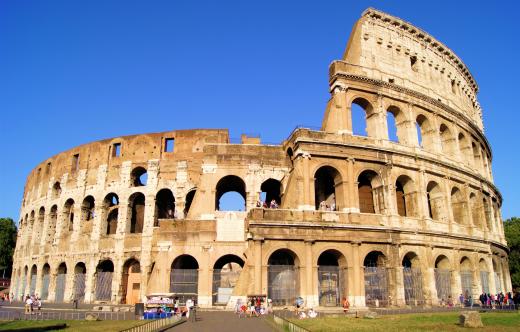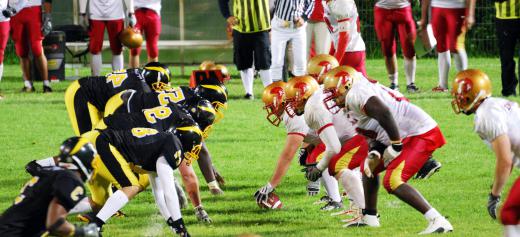A stadium is a structure that surrounds a central field or a stage in which a spectator event takes place. The structure holds seating for spectators to view the event, either by standing or sitting. Usually, every seat gives a spectator a complete view of the field, no matter where he or she is sitting.
The word stadium originates from the Greek word stadion, and the oldest and perhaps one of the most influential stadiums is in Olympia, Greece. The ancient Olympic Games took place in Olympia, dating from 776 BCE. This stadium was influential because it set a standardized length of approximately 210 yards (190 meters), the length of a typical sprinting event. The Romans also used the same basic length, 200 to 220 yards (180 to 200 meters), which is demonstrated by perhaps the most famous stadium, the Coliseum in Rome, Italy.
Stadiums were used in Roman times for gladiator fights and public executions, among other spectator events. Intricate underground tunnels had holding areas for slaves and animals. Examples of ancient stadiums survive throughout the world.

Today, there are three basic stadium designs: oval, horseshoe and open. An oval stadium includes seating all the way around the field and, due to the length of the football field it surrounds, is oval in shape. A horseshoe stadium is open at one end, while an open stadium may be open at both ends. Although a stadium is typically designed to be open-air, newer designs include dome roofs or movable, sliding roofs to protect the spectators, players and field from inclement weather.

The seating in a stadium usually consists of fold-down seats on terraced rows, starting at field level and gradually rising to what is known as the “nose-bleed” section, named for the rise in altitude. Although most stadiums have seating for spectators, some include standing areas and bleachers or benches for sitting. Large stadiums can seat upwards of 100,000 people, and some racing stadiums or speedways, such as the Indianapolis Speedway, can seat up to 250,000.

Today, the stadium houses a variety of events. Although the word stadium usually references a building designed for any outdoor sporting event, stadiums are usually designed for American football and soccer events. Ballparks used for baseball games can also be referred to as stadiums. Often, people confuse stadiums with arenas, which are venues that support indoor sporting events such as basketball. With the rising popularity of National Association for Stock Car Auto Racing (NASCAR), more speedways are being built using a stadium design.

Stadiums can be either multi-use for designated for one of several types of sporting events, including track, soccer and football. Washington State’s Qwest Field & Event Center, which is home to the Seattle Seahawks, provides a venue for job fairs, soccer games, trade shows and concerts. It has a rolling roof that is 760 feet (231.6 meters) long and weighs 5,200 tons (226.8 metric tons). Although this is a benefit to the city, many cities have decided to build single use stadiums instead. Kansas City, Missouri started the trend toward building single use stadiums in the early 1970s with Kauffman Stadium, which houses the Royals baseball team, and Arrowhead Stadium, which houses the Kansas City Chiefs football team.

Commercialism is alive and well in the sporting industry, and stadium naming rights are a hot commodity among corporate sponsors. Corporations are willing to shell out millions of dollars to name a stadium, and many stadiums have undergone numerous name changes over the years, much to the chagrin of local fans. To date, the highest price paid in the United States was the 10 million US dollars (USD) paid by Reliant Energy in Houston, Texas to name the home of the Texans football team Reliant Stadium.
